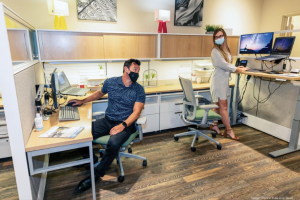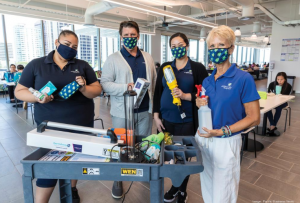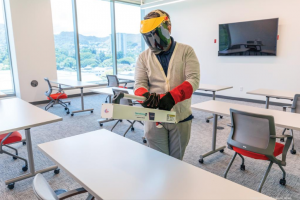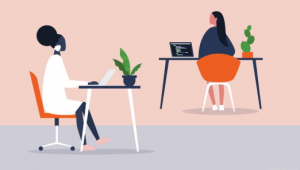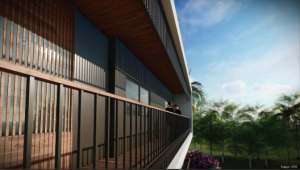There isn’t a business that isn’t considering what it needs to change in its physical environment to meet both mandates from government as well as customer and employee expectations regarding health, hygiene and safety concerns surrounding the coronavirus. PBN checked in with experts of office space, plus banks and hotels, to find out what they’re planning.
OFFICE
More companies are starting to return to the office in Downtown Honolulu this summer as the economy reopens from the Covid-19 shutdowns with social distancing signage, an increased focus on hygiene and cleaning and plexiglass barriers between workstations.
But the majority are holding off on making major changes to their work spaces, especially those companies that are in the middle of a long-term lease with a hefty investment in furniture, fixtures and equipment.
At this point, most local companies are not thinking so much about the office of the future, but more about the office of next week.
“I think everyone is trying to figure that out right now,” said Sean Tadaki, managing partner and principal broker at Commercial Asset Advisors. “Everyone’s doing the most they can, this is all across the board.”
What Tadaki means is that office buildings in Downtown Honolulu are placing “hand sanitizer stations everywhere, they’re putting the stickers in the elevators — I’ve seen as little as two, at most four, people per elevator and stickers all over the place, showing people directionals.”
“The reality of it is, if and when we can we get fully up to speed again, back-of-the-napkin kind of numbers for a high rise office tower of 700 to 800 people, it could take over 10 hours to get everybody up if there’s only two people for a car,” he said.
It’s what happens once those employees get up to the company’s floor that landlords and tenants are still trying to figure out, said Brandon Bera, vice president of office and investment services at Colliers International Hawaii.
“For us, I think we need to see how 2020 plays out — are we even out of the woods on this first flare up in the pandemic or is it going to come back? If it comes back that’s when you start to see if there’s a little more fear in the market,” he said. “Right now I think it’s more of a serious hiccup, and both parties, they’re just working together and trying to get through, whereas if this flares up again, then you start getting into the potential for people having to dig their heels in because it gets more serious for their business.”
For tenants who have two or more years left on a lease, there’s not a lot that can be done, Bera said. Office furniture systems cost thousands, if not tens of thousands of dollars — a large firm can invest up to $1 million — and most businesses are not looking to spend money during the pandemic-driven recession.
Either way, businesses need to make adjustments to bring people back into office spaces. Some companies are allowing their employees to continue working from home at least part of the time, incorporating staggered schedules to reduce the head count on any given day.
“The biggest request we get is, how can I make my office safe, help my health and safety and Covid standpoint with the least amount of dollars,” Bob Egbert, vice president of contract furniture company The Systemcenter Inc., which is the Hawaii dealer for Haworth office furniture and several other lines. “And oftentimes … they’ll tape off one desk in between two workstations, and just clean it out, and then we’ll put up the screens and things like that and so they’re just holding water, and that’s really a neutral position — we’re working remote, got a staggered schedule.”
Systemcenter’s Vince Krause, director of sales and marketing, and Anete Jayaweera, commercial project coordinator/designer, show off a workstation designed for social distancing.
EUGENE TANNER | PBN
Manufacturers, meanwhile, are coming up with innovative products that can separate workers in an office setting so companies don’t have to settle for plain plexiglass barriers or screens, said Miki Lee, business development and marketing manager at Infinium Interiors.
For example, the manufacturer 3form sells a frosted acrylic desk partition that covers three sides of a desk, and other acrylic dividers that come in a variety of patterns.
Many of the newer products, even fabrics originally designed for health care settings, hold up to repeated cleanings with bleach and other cleaning products, she said.
Beverly Clemente, an interior designer at WCIT, a Honolulu-based architecture firm, said clients are also looking to cut down on fabrics and other soft materials where the virus could linger, and said she and other designers are even looking at reducing the number of crevices and seams on surfaces where germs can hide.
“Then just getting back to that very sleek and ultra-contemporary design,” Clemente said. “ … But for us as interior designers, we want to balance [the surfaces] — a lot of the downfalls of having just hard surfaces everywhere is acoustics.”
Lee points out that one of the products that can serve as a privacy screen or barrier does double duty as an acoustics absorber. The product is made from P.E.T. that comes in a variety of colors and patterns and hangs from the ceiling, where it magnetically connects to the ceiling frame.
Some businesses have more flexibility with their space and layout, Egbert noted. Some office furniture that’s even 10 or 20 years old may integrate with newer pieces if it’s all part of a system, he said.
“The companies that invested in furniture that is part of a system, by design, whether it was knowingly or unknowingly, a benefit to them is that they can adapt that furniture in different configurations to address the health and safety concerns,” Egbert said. “Say you’ve got a quad workstation with four desks and chairs … what can happen is you can take that existing investment, reconfigure it, and you can have the workspaces facing different directions and then on each side of the panel new plexiglass or dividers, and what you end up with is a workspace that does satisfy the return-to-work realities.”
But companies that in recent years added a “benching” layout, with desks pushed close together, will have to either leave a vacant desk or space them out, in addition to installing screens.
Leanne Hachey, marketing manager at Contract Furnishers of Hawaii Inc., which does business as Office Pavilion, predicts that style of seating, which was already falling out of favor, will go away faster now with social distancing.
Hachey’s company is the Hawaii dealer for the furniture manufacturer Herman Miller, which recently published a report saying screens are not the ultimate answer, “but that’s what everybody’s running to.”
“Honestly, their answer is it’s the people, it’s going to be people and their hygiene, people and their abiding by distancing protocols,” she said. “It comes down to people – furniture isn’t the answer.”
BANKING
Much like other industries, financial institutions are thinking about how to best structure branches and headquarters to best respond to the pandemic-related workplace safety concerns.
Many of these changes are obvious, added plexiglass shields at teller lines, queueing customers six feet apart, face mask mandates and increased sanitation. Other, less obvious, internal operational changes and decisions are being made behind the scenes.
PBN talked with two local banks that have recently invested heavily in their headquarters to see what changes are being made and what is top of mind for banks moving forward.
American Savings Bank moved 650 bank employees into its 11-story, $100 million new headquarters last year — the first new office building built in Honolulu in more than 20 years. Beth Whitehead, executive vice president and chief administrative officer, said that when building ASB’s new home, the bank took every precaution to prepare for anything and everything — including a pandemic.
“Air circulation is key,” she said. “We had to think to ourselves, if a pandemic happened, would our building be prepared?”
Little design elements, such as building the ceiling heights between 15 to 21 feet, were chosen to help with air circulation and dissipation of germs. On the technical side, the building’s state-of-the-art Global Plasma Solutions HVAC system continually replaces and circulates fresh outside air throughout the building, using ionization units to neutralize particulate matter, bacteria and virus cells.
Back in January, ASB also immediately increased frequency of cleaning and sanitation crews that use antibacterial wipes to wipe down all surfaces every night before a portable UV cleaning comes through a few hours later to sanitize again.
American Savings Bank has implemented a rigorous cleaning schedule, with disinfectant cleaning products and UV lights cleaning work areas daily.
EUGENE TANNER | PBN
An American Savings Bank employee demonstrates how the UV cleaning lights disinfect desks every night.
EUGENE TANNER | PBN
As for the layout of the new building, Whitehead said that not much will operationally change. Desks are already six feet long, but furniture in the collaboration spaces and conference rooms have been significantly reduced. A conference room, for example, that may have a room capacity of 22 people is capped at nine for now.
“We didn’t create a one-touch-all return to work plan,” Whitehead said. “We did a survey on our employees’ biggest concerns and are working with our HR team and managers to find the best fit for that team. We want to do what’s right for each particular team, and their comfort levels.”
Central Pacific Bank, on the other hand, is still constructing its remodeled HQ at the corner of S. King and Alakea streets in the financial district downtown. The construction is part of the bank’s $40 million RISE2020 modernization plan, unveiled in late July of last year.
“Amid the Covid-19 pandemic, we also performed analyses of our flagship main branch construction and transformation,” Catherine Ngo, president of Central Pacific Bank, said. “In addition to ensuring employee and customer safety, we have achieved a flexible design that can provide an exceptional and dynamic customer experience over time.”
Looking ahead, the bank plans to set furniture further apart to allow for social distancing, select fabrics and other materials more ideal for cleaning, develop procedures that can better control space reservations and traffic flow, and create signage to inform employees and customers of the new procedures.
Ngo told PBN that when CPB launched the initiative, it could not have foreseen the new environment presented by the pandemic, but said the bank is continuing full-steam ahead with its RISE2020 goals and construction.
“The investment itself, to modernize our digital banking and branch experiences, was centered on meeting the changing needs of our customers and the community,” Ngo said. “Being agile and innovative was innate to our project team and approach from inception.”
A few of the RISE2020 initiatives included a new online and mobile banking platform and network of smart ATMs. The bank’s new website has already been rolled out, but CPB is on track to introduce these digital banking enhancements throughout the summer.
“As we plan for the opening of CPB’s reimagined headquarters on Jan. 4, 2021, we are carrying forward the utmost care and sensibilities in our floor plan, furnishings, and procedures to ensure standards like social distancing and sanitation are well adhered to,” she said. “With these measures in place, we remain committed to providing our network of customers, small businesses, and nonprofits access to co-working space, meeting rooms, and our indoor-outdoor lanai for collaboration and community building, which are critical to thriving beyond the coronavirus crisis.”
CPB will approach its return-to-work plan in phases. Some areas of the organization have found that working remotely and teaming virtually is preferred, so the bank is investing in the infrastructure to enable this moving forward. CPB is piloting an internal program that provides flexible workstations for its employees when they may need to work in an office setting.
“In navigating the new normal, we will continue to flex our muscles in being nimble while maintaining a caring environment conducive to unwavering support of our customers and the community,” Ngo said.
Offices, banks and hotels are among the Hawaii workplaces rethinking what their spaces should look like now.
GETTY IMAGES / NADIA BORMOTOVA
HOSPITALITY
Among G70’s hospitality clients is one developer who decided to pause construction on a new resort when the pandemic hit in order to redesign the property with Covid-19 in mind.
Craig Takahata, a principal of the architecture and planning firm, pointed out that there are many new concerns that hotels and resorts have to consider in the post-Covid era — everything from how to best structure guest rooms to incorporating social distancing in common areas.
Here are just a few of the ways that Covid-19 might shape hospitality design in the future.
Natural-air cross ventilation and generous lanai areas, as seen in this rendering of a G70 project, could be among post-Covid trends in hospitality design.
COURTESY G70
Communal areas could be restructured.
Takahata said that Covid-19 could influence the design of communal areas within hotels and resorts, starting from the arrival experience. Properties may structure layouts in a way that facilitates the flow of guests as they arrive, check in, and head to their rooms.
“With social distancing, we want to avoid cross traffic as much as possible … We’re trying to break down the masses of people in one area,” Takahata said.
Altering designs to optimize natural airflow could be one prominent trend.
“In communal areas especially, you have to pay attention to the circulation of air throughout the space so that you’re not having stagnant air,” Takahata said.
The good news, he said, is that that’s something Hawaii hotels have largely been doing for years. Hawaii hotels often feature open-air lobbies and corridors, but Takahata said developers will look for additional opportunities to increase airflow in the future.
Hotels may opt to decrease the square footage of communal areas, said Robert Payan, senior vice president of architecture firm WATG.
“The trend of ‘neighborhood hotels’ encouraging guests to congregate and socialize with each other, and neighboring residents, is expected to diminish during Covid-19,” he said.
Over the years, Payan explained, some hotels have decreased the size of guest rooms in favor of larger common areas. Now, however, he said the trend is reversing, as hotels “are beginning to prioritize individual guest rooms as multi-functional living/dining/gym areas.”
“Communal indoor areas may continue to decrease in size as social distancing trends increase,” he said.
Guest rooms might look a bit different, too.
While Takahata said that it’s nothing new for guest units to be zoned into public and private areas, he said that the pandemic has revealed a new need for isolation zones.
“We’re looking at how we can zone areas so that if there is ever a need for quarantine or isolation, there is a means to accommodate that,” Takahata said. “In the future, it might not mean that they have coronavirus, but just that they’re not well … and there will be a zone for that within the unit.”
In larger rooms, Takahata said that this could entail a separate bedroom or office attached to a private bathroom and possibly its own lanai.
Payan said that the existing trend toward multi-purpose spaces in hospitality will accelerate amid the pandemic, including for guest rooms.
“[Guest rooms] need to be designed to function well and fulfill the need to rest, work and possibly recreate within that single private space,” he said. “For guests traveling with potential pre-existing health conditions, this will become even more important.”
Technology will play a more prominent role.
In recent years, hotels already have begun to integrate tech — such as contactless entry and in-room smart technology — into their operations. Experts predict the use of these types of systems will likely be accelerated by the pandemic.
“We will absolutely see technology playing a bigger role in the hospitality guest experience,” Payan said. “Contactless and virtual check-in will continue to be a trend, as guests will continue to command control over their travel experience.”
Some international hotel brands already have eliminated front desks, which Payan said, “creates a great new opportunity for more creative, flexible lobby design.” Other hotels might reduce the size of their lobbies using a mix of front desk staff and check-in technology.
As for in-room technology, hotels may adopt tools like Siri or Alexa to allow guests to control the lighting, air conditioning and other elements of their unit.
“These are things that people are already using at home, but incorporating them into the guest experience for the hotel,” Takahata said.
Offices, banks and hotels are among the Hawaii workplaces rethinking what their spaces should look like now.
GETTY IMAGES / NADIA BORMOTOVA
“Landscape architectural renovations can have a huge impact on the guest’s overall experience and add considerable value to a hotel or resort,” Payan said. “With Covid-19, we know that being outdoors is safer, and guests are likely to feel safer and more comfortable socializing outside.”
With that in mind, Bernice Fielding, a project manager at WATG, said there is a chance now to better utilize nature within hospitality spaces. Fielding, who manages the firm’s resort projects in planning and landscape design, said that the event lawns that many properties have represent one opportunity to do that.
“These are spaces that right now, and for a long time, are not going to be able to be used as large event spaces,” she said.
Fielding said that plants could be used to section off areas on the lawn to create private green spaces for any number of revenue-generating activities — yoga, outdoor dining, spa treatments, or anything else hoteliers can think of.
Another option, she said, could be to create on-property eco-tourism activities.
“Some people come here and they want to go work on a farm on the North Shore, or they want to go to a loi,” Fielding said. “Instead of piling yourself into a car to go do eco-tourism with a bunch of people you don’t know, maybe there is an opportunity on the actual hotel grounds to incorporate some of these things.”
“That would give hotels the opportunity to still produce revenue but in a completely different way.”

